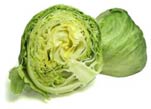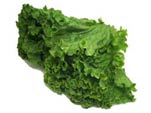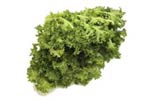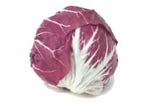
This vegetable is widely popular throughout the world and is readily
available in supermarkets year round with hundreds of varieties to choose
from. Iceberg used to dominate the selections but other varieties are now
moving to the forefront. Most domestic varieties are from California and
imported lettuce typically arrives from Europe.
|
The lettuce that we see today, actually started out as a weed around
the Mediterranean basin. Served in dishes for more than 4500 years,
lettuce has certainly made its mark in history with tomb painting in Egypt
and identification of different types of lettuces by various Greek
scholars. Christopher Columbus introduced lettuce to the new world and
from there, lettuce in the United States began cultivating.
Most dark greens are good sources of Vitamin C and other nutrients.The
rule of thumb is, usually, the darker the greens, the more nutritious the
leaf.
|
| |
|
Lettuce (Romain, Shredded) |
Serving Size
1 cup chopped, raw (56g)
|
Amounts Per Serving |
%
Daily Value |
| Calories
10 |
|
| Calories
from Fat 0 |
|
| Total Fat
0g |
0% |
| Saturated
Fat 0g |
0% |
| Cholestrol
0mg |
0% |
| Sodium 0mg |
0% |
| Total
Carbohydrate 2g |
1% |
|
Dietary Fiber 1g |
4% |
|
Sugars 1g |
|
| Protein 1g |
|
| Vitamin A |
70% |
| Vitamin C |
20% |
| Calcium |
2% |
| Iron |
4% |
* Percent Daily Values are based on a 2,000 calorie diet.
|
|
| |
|
|
There are four main types of lettuce and under each type there are
different varieties.
 |
Butterhead (includes Boston and Bibb)
Loose heads, grassy green leaves, butter texture, mild flavor. Good
examples are Boston lettuce, which looks like a blooming rose, and
Bibb lettuce that has a small cup-shaped appearance. |
 |
Crisphead
The least nutritious of the salad greens, this pale green lettuce
takes on the cabbage appearance with its leaves more tightly packed
together. An example is the Iceberg lettuce. It's known for the crispy
texture and very mild flavor. |
 |
Looseleaf
This variety doesn't grow to form lettuce heads, but is instead the
leaves are joined at the stem. Good examples of this variety include:
oak leaf, red leaf, and green leaf. |
 |
Romaine or Cos
This lettuce has gained tremendous popularity in the past decade as
the key ingredient in Caesar salads. It has a loaf-like shape with
darker outer leaves. It's strong taste and crispy texture has been
favored by those who like Iceberg lettuce. |
 |
Arugula (rocket or roquette)
This variety used to be hard find, but can now be found at many
supermarkets. This variety is characterized by small, flat leaves with
long stems, quite similar looking to dandelion leaves, and a peppery
taste. This lettuce is usually paired with other varieties to balance
out the taste. |
 |
Belgian endive or French endive
This leaf is a family member of chicory and escarole, with tightly packed
leaves and bullet-like shape. Creamy yellow or white in color, slightly
bitter in taste, but crisp in texture. |
 |
Chicory or curly endive
This leaf is slightly bitter, with darker outer leaves and paler or
even yellow leaves towards the center. The leaves itself are ragged
edged on long thin stems. |
 |
Escarole
Another member of the chicory family, this lettuce has broad wavy
leaves and a milder taste than chicory. |
 |
Mâche or lamb's lettuce or field
salad
With a fingerlike shape, velvety feel, and mild taste, this variety is
usually sold bunched together with its roots, at an expensive price
due to its delicate and perishable nature. |
 |
Raddicchio
This variety looks like red cabbage, but it's actually a chicory
family member. This leaf is typically used for an accent in salads
because of its steep cost as most radicchio lettuce arrives from
Italy. |
Lettuce is a delicate vegetable and great care should be taken when
selecting and storing. Most lettuce is showcased on ice or in
refrigeration. When selecting your leaves, be sure that they are fresh and
crisp, with no signs of wilting, slim, or dark spots or edges. Remember
when selecting your lettuce that the darker outer leaves are the most
nutritious.
Lettuce tends to keep well in plastic bags in the crisper section of the
refrigerator. Iceberg lettuce keeps the best, lasting around two weeks,
while Romaine, ten days, and butterheads types and endives lasts
approximately four days. The very delicate greens don't last very long, so
it's best to buy only as much as you need at one time and use immediately.
Salad greens should not be stored near fruits that produce ethylene gases
(like apples) as this will increase brown spots on the lettuce leaves and
increase spoilage. Greens that are bought in bunches should be checked for
insects. Those leaves that have roots should be placed in a glass of water
with a bag over the leaves and then placed in the refrigerator.
Generally lettuce is eaten raw, so consider removing any browned,
slimy, or wilted leaves. For all lettuce types, you should thoroughly wash
and 'dry' the leaves to remove any dirt or lingering insects. If you eat
lettuce often, it's wise to invest in a salad spinner. Simply rinse the
leaves and place in the spinner to remove the excess water.
In addition to their most common use in salads, you can also braise,
steam, sautè and even grill certain lettuce varieties to create a
wonderful and different taste treat. Try halving a head of radicchio or
romaine lengthwise, and brush on some extra virgin olive oil, and grill
until they soften and just begin to brown-absolutely delicious.
Recipes
Sweet and Sour Leafy Green Salad
Serves 4
Each serving equals 3 1/4 cups of fruits or vegetables
Source: Produce for Better Health
Ingredients
5 cups Romaine lettuce leaves, torn and lightly packed
3 cups spinach leaves, lightly packed
2 cups mushrooms, sliced
2 oranges, peeled and sliced
1 cup pitted prunes, halved
½ cup red onion, sliced
½ cup nonfat honey-mustard dressing
¼ to ½ tsp black pepper, coarsely ground
Toss all ingredients in a large bowl.
Nutritional analysis per serving: Calories 200, Fat 1g, Calories from
Fat 3%, Cholesterol 0mg, Fiber 7g, Sodium 365g.
Find more in our
recipe database!
|



